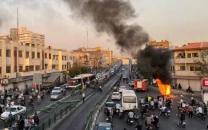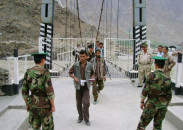Armed guards at India dams as drought leaves farmers dry
About 330 million people, or a quarter of the population suffer from drought after the last two monsoons failed

PHOTO: REUTERS
Desperate farmers from a neighbouring state regularly attempt to steal water from the Barighat dam, forcing authorities in central Madhya Pradesh to protect it with armed guards to ensure supplies.
‘Drought-Hit’ Tharparkar: Free wheat distribution soon: govt
India is officially in the grip of its worst water crisis in years, with the government saying that about 330 million people, or a quarter of the population, are suffering from drought after the last two monsoons failed.
"Water is more precious than gold in this area," Purshotam Sirohi, who was hired by the local municipality to protect the stop-dam, located in Tikamgarh district, told AFP.
"We are protecting the dam round the clock."
But the security measures cannot stop the drought from ravaging the dam in the parched Bundelkhand region, with officials saying it holds just one month of reserves.
Four reservoirs in Madhya Pradesh have already dried up, leaving more than a million people with inadequate water and forcing authorities to truck in supplies.
Almost a hundred thousand residents in Tikamgarh get piped water for just two hours every fourth day, while municipal authorities have ordered new bore wells to be dug to meet demand.
But it may not be enough, with officials saying the groundwater level has receded more than 100 feet (30 metres) owing to less than half the average annual rainfall in the past few years.
"The situation is really critical, but we are trying to provide water to everyone," Laxmi Giri Goswami, chairwoman of Tikamgarh municipality, told AFP.
"We pray to rain gods for mercy," she said.
In the nearby village of Dargai Khurd, only one of 17 wells has water.
With temperatures hovering around 45 degrees Celsius, its 850 residents fear they may soon be left thirsty.
‘Thar only makes the news when there’s drought and deaths’
"If it dries up, we won't have a drop of water to drink," Santosh Kumar, a local villager told AFP.
Farmers across India rely on the monsoon -- a four-month rainy season which starts in June -- to cultivate their crops, as the country lacks a robust irrigation system.
Two weak monsoons have resulted in severe water shortages and crop losses in as many as 10 states, prompting extreme measures including curfews near water sources and water trains sent to the worst-affected regions.
Many dejected farmers are now moving to cities and towns to work as daily wage labourers to overcome their financial losses and support their families.
At a scruffy, makeshift camp in north Mumbai, in one of the worst-affected states, dozens of migrants who have fled their drought-stricken villages queue to fill plastic containers with water.
Migrants from rural areas usually come to the city in January or February to get jobs on construction sites, but in March and April the number of arrivals kept increasing.
"There are some 300-350 families here. That's a total of more than 1,000 people," said Sudhir Rane, a volunteer running the camp in Mumbai's Ghatkopar suburb.
"There is a drought and there is no water back home so more families have come here this year," he told AFP.
Babies cling to mothers lined up to register with officials. They are allocated a small space in the dusty wasteland, where wooden posts combine with tarpaulin sheets to make rickety tented homes.
"We had no choice but to come here. There was no water, no grain, no work. There was nothing to eat and drink. What could we do?" 70-year-old Manubai Patole told AFP.
"We starved for five days. At least here we are getting food."
Weather forecasters in New Delhi this month predicted an above-average monsoon, offering a ray of hope for the country's millions of farmers and their families.
But many, like Gassiram Meharwal from Bangaye village in Madhya Pradesh, are not optimistic as they struggle to cultivate their crops.
Meharwal's two-acre farm has suffered three wheat crop failures in as many years, leading him to lose an estimated 100,000 rupees ($1,500).
"Our fields are doomed, they have almost turned into concrete," he said.
Balochistan Downpour: Rain brings joy in plains, woes in cities
Thousands of acres of land in his village go uncultivated and fears are mounting for the cattle, which face a shortage of fodder.
Desperate for income, 32-year-old Meharwal, who supports eight members of his family including his children and younger brothers, left to work as a labourer in the city of Gwalior, four hours away.
"There is no guarantee that it will rain this year. Predictions are fine but no one comes to your help when the crops fail," he said.
"It is better to use your energy breaking stones."



















COMMENTS
Comments are moderated and generally will be posted if they are on-topic and not abusive.
For more information, please see our Comments FAQ